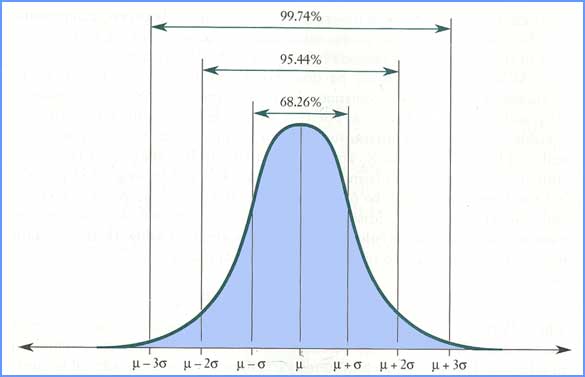The subsidiary patient
Many times, in my practice, I am required to explain some statistical concepts to my patients in order to make them avoid some frequent pitfalls. The most common concept I explain is what is “normal” in lab exams.
Let’s suppose someone invents a new lab test to measure the glucose in the blood. How would we determine what are the normal values for this test? Once we are certain that the exam will not harm anyone, the researcher start looking for HEALTHY (this is important) subjetcs in order to measure their blood glucose levels. The researcher will probably measure thousands of blood samples, put them in a graph and what will she/he find?

Normal distribution
The normal distribution has some interesting properties. The one we are using in this example is the one above. It is possible to calculate the proportion of the subjects (area under the curve) in each point. If we evaluate the area between μ-2σ and μ+2σ, we will find out that it corresponds to about 95,44% of the whole population Here you are. I thereby declare that the “normal” values in this alb tests are found between μ-2σ and μ+2σ, as 95% of all the healthy people are found in this interval.
Whenever a patient comes to see me, and I decide to test her/his glycemia using the method we have just described, there will be a chance, intrinsic to the method, that it will give a result that is out of the boundaries determined as “normal” limits, even though the patient is completely healthy. This chance, as explained, is about 5% (2.5% for each side of the distribution). Somebody may say: “OK, Karl, nothing is perfect and there is always margin for error.” I agree. The problem is that we never ask for only one exam. On one hand, patients love to do a full check-up “Please, test me for everything because my health plan will cover everything”. On the other hand, doctors love to ask for exams “I will ask for all the exams since blood will be drawn anyway”. In Brazil, doctors ask for an average of 1o to 20 tests per consulattion, depending on the specialization and health plan.
(OK, now it is time to PANIC) When we ak for 1 test, the chance of this test come back as NORMAL/NEGATIVE and the patient does NOT have the tested disease, is 95%, or 0.95. If we ask for 2 tests, the chances of both test come back normal and the patient does not have the tested disease is 0.95 x 0.95 = 0.9025. That means that there is about 10% of chance of one of the test come back as ABNORMAL/POSITIVE and the patient is healthy. If you consider 4 tests, the chances are 0.81 and when we achieve the number of 16 tests, the chances of one test coming back as abnormal is a THIRD!
The conclusion is quite important. Whenever I ask for a brazillion of tests, the chances that at least one of the results will come back abnormal and the patient is healthy is overwhelming. If I am, as I usually say, a doctor that is “hostage” of the exams, I will look for diseases where there are none! I will keep trying to fit the patient in the test results and not the opposite! This is what I call of “subsidiary patient, when the tests are what matter.
Some years ago, there was a trend in Brazil to take some flock of hairs and send them to USA, where they examined for almost all the elements in the periodic table! There were more than 50 exams. And who knows how the normal values for, let’s say, Cadmium, were established. The chance of at least one of the tests coming back as NOT NORMAL was close to 100%. Then, the doctor, in possession of the lab results, would say “Your Cadmium levels are high! We have to detoxify you!” and would prescribe you with some medicine. Some patients would become better, of course, and the rest of the herd would follow…
That’s something that is always on my mind: how many doctors today would have the guts to ignore a lab test just because it does not fit with the picture he drew from his patient? Hard question. Another: what kind of patients would believe his doctor if she/he decided to ignore the lab test? This one is easier: a patient that do not want to become subsidiary.
==================================
This post was written by Karl in his blog Ecce Medicus and translated by Carlos Hotta.







Discussão - 4 comentários
"he"?
Hi Rosie,
I apologize for the "he". In Portuguese, some words like doctor have genders. For some reason, whenever the gender of the word is not clear, the default is "he". When I translated the text, I had not taken that into account.
I cannot believe this will work!
So what is "normal", who decides this! Interesting piece, obrigado!